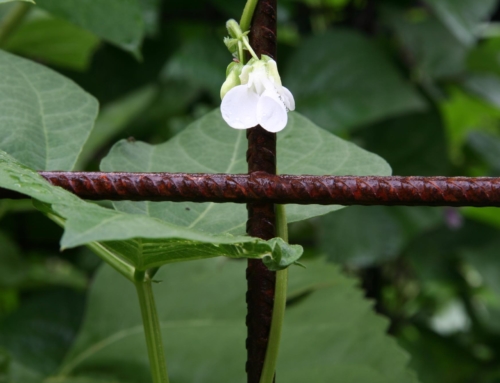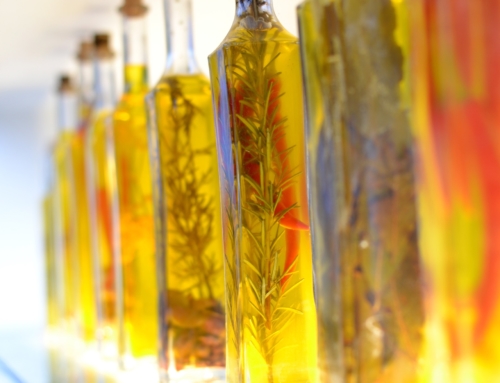Here are some more chronological pictures (up to Jan 23 2017) of beans climbing to 4 metres and still wanting to go higher if they had something to cling to. Interspersed between these pictures are extraordinary quotes from soil scientists and eco-agricultural, biological and nature attuned farmers.
This knowledge goes back to the early part of the last century, was buried and ignored soon after the fertiliser and pesticide boom after the 1940’s, but thankfully has been resurrected and is blooming via the eco-agriculture movement, largely initiated by Charles Walters in the USA. He started AcresUSA and it is going strong today even in Australia. Special thanks to Graeme Sait for interviewing many of these brave soil souls in his enlightening book “Nutrition Rules”.

Broad bean Flowers
These developed into large and tasty broad beans around the end of 2016.

Capturing rain water using a 300litre cucumber container
Wanted water that was free from chlorine and fluoride so that Compost Tea could be made successfully.
“You can encourage fungi growth in that medium, (compost tea) so long as you supply a surface for the fungi to grow on. This is why it is important to add kelp or humic acid to the brew. It is also important to re- strict brewing time to 24 to 48 hours from a fungal point of view. After the fungi have germinated, they don’t survive well in this medium beyond two to three days.” from a Nutrition Rules interview with Dr Elaine Ingham.

Beans moving along.
Wooden plank situated so I could move between rows without compressing the soil. Microbes and fungi don’t like their home being crushed.
“Endomycorrhizal fungi … their maze of hyphae filaments effectively increases the original surface area of the roots by up to 1000% with a remarkably productive outcome. Root benefits are magnified tenfold and the plant is perfectly positioned to achieve its true genetic potential.” from Nutrition Rules by Graeme Sait

mycorrhizal fungi filaments under microscope
This picture was taken through my microscope using an iPhone placed over the eyepiece. The sample came from the compost heap. Yes they are mycorrhizal fungi filaments – mycelium running as renowned mycologist, Paul Stamets would say.

Bean plants love the wire mesh
“Don’t Rotate Your Plants! – All living plants have a critical rotational position (CRP), which is established at the time of their germination. The CRP is linked to the Earth’s magnetic field. Transplanting experiments clearly show that plants rotated away from their CRP are set back in their growth and health compared with those given their original orientation. This important feature of plants was discovered by Frances Farrelly, a gifted medical technician, and healer, in the early 1970’s. (Source: Tompkins and Bird, The Secret Life of Plants, 1974.) via BAA “Between the leaves” newsletter.

Flowers from a variety of bean called “Scarlet Runner”
These are new in the garden this year. They have large scarlet and white seeds when dried. Looking forward to see what the seed (Legume) taste like. The bean itself while growing is green with a remarkably tough texture.

A tough textured Scarlet Runner bean
A monster Scarlet Runner bean.
“The soluble carbon exuded into the rhizosphere by perennial groundcover plants and/or transported deep into soil by mycorrhizal fungi, provides energy for the vast array of microbes and soil invertebrates that produce sticky substances enabling soil particles to be glued together into clumps (aggregates).
When soil is well aggregated, the spaces (pores) between the aggregates allow the soil to breathe, as well as absorb moisture quickly when it rains. A healthy topsoil should be ‘more space than stuff’, that is, less than 50% solid materials and more than 50% spaces.” Dr Christine Jones

Sunflowers provide a natural trellis for beans to climb up
And so do corn and amaranth plants.

Strong and healthy amaranth plants can provide a trellis for beans to scale
“When once we appreciate the soil as a factor in the drought, then we can use the years of no such damage to build the soil fertility for less of disaster from the drought when it occurs. Fertility is the major means of managing soil to mitigate drought damage, and to give bigger crop returns when there is no drought.” Dr William Albrecht from his article – The Drought Myth – An Absence of Water is Not the Problem

Purple climber beans – delicious and nutritious
These are the most prolific growers in any of the soil conditions in the garden. Last year they gave 2 crops in one season with the extended summer. Recently tried some of the dried beans I had stored away. They were delicious and reminiscent of kidney beans in both size and colour.

Scarlet Runner

Purple climber @ 3.5 metres
An experiment to see how high they would go – unstoppable. And they are producing beans at this height. By the way these plants are growing out of pots!!

Beans and pumpkins
Beans, pumpkins, corn and sunflowers scaling the neighbor’s fence and beyond…

No toxic chemicals and so much life everywhere.
And finally from last year’s crop of purple climbers – soaked for 12 hours, germinated for 48 hours. They were then cooked for several hours. They went much darker after being cooked. Almost like red kidney beans. Delicious and much reduced in anti-nutrients because of the important soaking and especially the germinating stages. No farting from these babies!!

Purple climbing beans – soaked and germinated
Special thanks to Richard Makim for giving me a copy of “News Leaf” from Biodynamic Agriculture Australia. Among many things of interest in this tiny booklet, were the details of how to order basalt crusher dust and Palagonite for the garden. The crusher dust comes from Dorrigo and the Palagonite from close to Brisbane. They have powerful but different paramagnetic properties and values. Both great for increasing natural mineral content into the soil.






Looking great , Hartmut. Get your refractometer out and let us know how they are going. I think Elaine updated the tea idea, while teas are great, they can be difficult to manage in extraction over 24hrs or longer. She told us in a compost making course, to go for extracts, over a couple of hrs, and get 80% of the tea result 100% of the time. The teas can go anaerobic and lose the lot, too easily.
Thanks Richard. I don’t currently have a refractometer. I know the meterman sells them. Can you recommend the best all round one to buy.